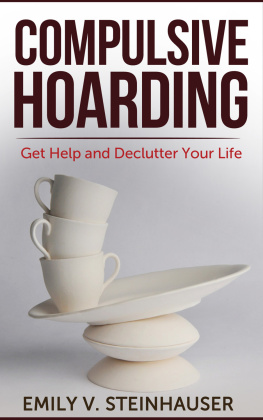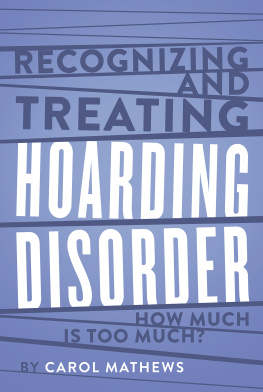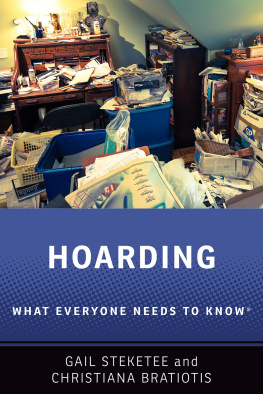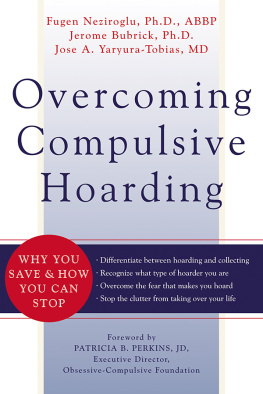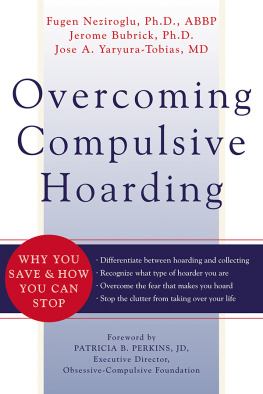HOUGHTON MIFFLIN HARCOURT
BOSTON NEW YORK
2010
Copyright 2010 by Randy O. Frost and Gail Steketee
All rights reserved
For information about permission to reproduce selections from this book,
write to Permissions, Houghton Mifflin Harcourt Publishing Company,
215 Park Avenue South, New York, New York 10003.
www.hmhbooks.com
Library of Congress Cataloging-in-Publication Data
Frost, Randy O.
Stuff : compulsive hoarding and the meaning of things / Randy O. Frost
and Gail Steketee.
p. cm.
Includes bibliographical references.
ISBN 978-0-15-101423-1
1. Obsessive-compulsive disorder. 2. Compulsive hoarding.
I. Steketee, Gail. II. Title.
RC 533. F 76 2010
616.85'227dc22 2009028273
Book design by Victoria Hartman
Printed in the United States of America
DOC 10 9 8 7 6 5 4 3 2 1
Our work on hoarding began more than fifteen years ago with our first study of people struggling with this problem. Work on this book began more than seven years ago when we met and gained the cooperation of the people portrayed here. We dedicate this book to all of these people for their willingness to open their lives to us. We remain in contact with many of them. We have changed identities and details not germane to their stories, while striving to represent their struggle with hoarding as we understand it from their narratives. It is ironic that those who struggle the most with hoarding and its sometimes severe consequences have helped us so much to comprehend their experience and record it as best we can. Our hats are off to all of them, whether their stories appear here or not. They have helped us more than they can know, and we hope that through this book others will understand their plight.
CONTENTS
Dead Body in the Collyer Mansion: A Prologue to Hoarding 1
Piles upon Piles: The Story of Hoarding 17
We Are What We Own: Owning, Collecting, and Hoarding 44
Amazing Junk: The Pleasures of Hoarding 63
Bunkers and Cocoons: Playing It Safe 83
A Fragment of Me: Identity and Attachment 99
Rescue: Saving Animals from a Life on the Streets 118
A River of Opportunities 134
Avoiding the Agony 152
You Haven't Got a Clue 169
A Tree with Too Many Branches: Genetics and the Brain 188
A Pack Rat in the Family 216
But It's Mine! Hoarding in Children 238
Having, Being, and Hoarding 262
Reference List 281
Acknowledgments 291
DEAD BODY IN THE COLLYER MANSION: A Prologue to Hoarding
Here, too, I saw a nation of lost souls,
far more than were above: they strained their chests
against enormous weights, and with mad howls
rolled them at one another. Then in haste
they rolled them back, one party shouting out:
"Why do you hoard?" and the other: "Why do you waste?"...
Hoarding and squandering wasted all their light
and brought them screaming to this brawl of wraiths.
You need no words of mine to grasp their plight.
Dante Alighieri, The Inferno
On Friday morning, March 21, 1947, the police in Harlem received a call. "There's a dead body in the Collyer mansion," reported a neighbor.
The call resembled many others the police had received over the years about the eccentric Collyer brothers, Langley and Homer, who lived in a three-story, twelve-room brownstone in a once fashionable section of Harlem. They dutifully checked it out.
The police arrived at the brownstone at 10:00 A.M. When they failed to get in through the front door, the crew used crowbars and axes to force open an iron grille door to the basement. Behind the door was a wall of newspapers, tightly wrapped in small packets and too thick to push through. The rear basement door was similarly blockaded with junk. A call to the fire department produced ladders, allowing the patrolmen to try windows on the second and third floors. Most were barricaded and impassable. By this time, the commotion had attracted hundreds of curious onlookers. Finally, two hours later, Patrolman William Barker squeezed through a front window on the second floor. What he found inside shocked him.
The house was packed with junknewspapers, tin cans, magazines, umbrellas, old stoves, pipes, books, and much more. A labyrinth of tunnels snaked through each room, with papers, boxes, car parts, and antique buggies lining the sides of the tunnels all the way to the ceiling. Some of the tunnels appeared to be dead ends, although closer inspection revealed them to be secret passageways. Some of the tunnels were booby-trapped to make noise or, worse, to collapse on an unsuspecting intruder. A cardboard box hung low from the roof of one tunnel, and when disturbed it rained tin cans onto any trespasser. More serious were booby traps in which the overhanging boxes were connected to heavier objects such as rocks that could knock someone out.
Patrolman Barker had to push his way over an eight-foot-high wall of stuff in a room with a ten-foot ceiling. In a small clearing in the center of the room, he found the body of sixty-five-year-old Homer Collyer in a sitting position with his head on his knees. Barker leaned out the window and called out, "There's a dead man here!" The emaciated body was covered only in a tattered bathrobe. Homer had not been seen by anyone for several years, and over the past few decades there had been numerous reports of his death. Many of the neighbors believed he had been dead for years, but the autopsy revealed that it had been only about ten hours.
Homer had been blind since 1933 and was nearly paralyzed with rheumatism. His brother, Langley, fed and cared for him. Langley once told the neighbors that since their father was a doctor and they had an extensive medical library, they had no need of doctors and could care for Homer's problems with a combination of diet (one hundred oranges each week) and rest (Homer kept his eyes closed at all times). The autopsy indicated that Homer died of a heart attack, probably brought on by starvation. Homer's body had to be lifted by stretcher down the fire ladder from the second-story window.
Despite the commotion, there was no sign of Langley. He'd last been seen several days earlier sitting on the steps of the run-down brownstone. Neighbors suspected he was still in the house, perhaps hiding. The Collyer brothers' lawyer, John McMullen, insisted that if Langley were in the house, he would come out. But by Saturday afternoon, there was sufficient concern over Langley's whereabouts that the police department issued a missing person alert. The hunt for Langley became so intense that on one occasion, after a sighting on the subway, the train was stopped just outside the station so that police could search all the cars. Several newspapers put up rewards for information on Langley's whereabouts. In the meantime, the police worried that Langley was indeed hiding somewhere inside the house.
In the days following the discovery of Homer's body, all the New York papers carried the story on the front page. "The Palace of Junk," read the Daily News on March 22. "'Ghost Mansion' Yields Body" read another headline. The Collyers quickly became household names.
When Langley failed to appear after three days, the police led an intensive search of the house. Thousands of spectators gathered to see what sort of mysteries would unfold. The house was in such deplorable condition that the Department of Housing and Buildings announced that it would have to be demolished or undergo extensive renovations to be habitable. Leaks from the roof had destroyed most of the upper floor. During inspection, the city building inspector fell through the third floor and was saved only by a conveniently placed beam.
Next page

